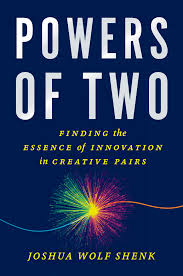Author: Joshua Wolf Shenk
ISBN: 978-0-544-03159-3
APA Style Citation
Shenk, J. (2014). Powers of Two: finding the essence of innovation in creative pairs. Boston: Houghton Mifflin Harcourt.
| open_your_class_power_of_two_7.pdf |
In Powers of Two: Finding the Essence of Innovation in Creative Paris, author Joshua Wolf Shenk rejects the idea of the lone genius in favor of evidence for the success of cooperative duos. The book reads like an autobiography of famous historical and contemporary pairs from business, music, literature, sports, art, politics, science, and technology. Joshua Wolf Shenk is also the author of the book Lincoln’s Melancholy: How Depression Challenged a President and Fueled His Greatness. Detailed accounts of famous pairs are woven throughout the book and include John Lennon and Paul McCartney, Susan B. Anthony and Elizabeth Cady Stanton, Mohandas Gandhi and Mahadev Desai, Sigmund Freud and Carl Jung and Steve Wozniak and Steve Jobs. Thorough research illustrates that many individuals historically perceived as lone geniuses frequently owed their success to close work with one other individual.
Shenk acknowledges three types of pairs that he describes as star and director, liquid and container, and dreamer and doer. In the star and director pair, one half of the duo occupies the spotlight, but their success is dependent upon the input of the other half who remains behind the scenes. Examples of famous star and director creative pairs include Mohandas Gandhi and Mahadev Desai, Martin Luther King Jr. and Ralph Abernathy, Vincent van Gogh and his brother Theo. The dynamic of the liquid and the container refers to pairs in which one individual is drawn to risk and excitement (liquid), while the other individual imposes constraints and introduces necessary order and organization. The liquid half of a pair typically is often more exciting, energetic, and more likely to take risks. These individuals work well in pairs when the other half serves as a container offering structure and restraint. This dynamic in particular according to the author is what gave rise to the romantic tradition of the lone, mad artist. The mad artist construct however only refers to the liquid half of the duo. The well-known Apple Computer advertising campaign “Here’s to the crazy ones” dramatically illustrates the lone genius myth “Alfred Hitchcock, John Lennon, Pablo Picasso, etc …the ones who see things differently… while some see them as the crazy ones, we see genius… Because the people who are crazy enough to think they can change the world are the ones who do.” According to Powers of Two, these wild geniuses were only successful in making dramatic change because they were partnered with another more grounded individual. One strong example of liquid and container highlighted throughout the book is the partnership of John Lennon (liquid) and Paul McCartney (container). The section on dreamer and doer pairs is creatively titled Inspiration and Perspiration and separates some famous pairs into the half who envisions new ideas and inspires others (dreamer), and the half who effectively sets priorities and finishes projects (doer). Examples of this type included in the book are Orville Wright (doer) and Wilbur Wright (dreamer), Jerry Seinfeld (doer) and Larry David (dreamer) andSouth Park’s Trey Parker (dreamer) and Matt Stone (doer).
The book describes how powerful pairs develop through six stages: meeting, confluence, dialectics, distance, and the infinite game. In the process the author provides details about the various manners in which these stages occur through references to psychological studies, interviews, and historical records. Countless well known pairs are explored in each of the six stages to illustrate common trends among productive duos. The book is a fascinating analysis of modern psychological research on creativity. Numerous references are made that apply to a wide range of topics covered in a psychology class including social psychology, biopsychology, motivation, emotion, stress, and states of consciousness, cognition, and development making Powers of Two an excellent resource for supplemental materials for class.
Other Related Resources
Author Joshua Shenk’s website with information about the book Powers of Two, and his previously released book, Lincoln’s Melancholy.
http://www.shenk.net/powersoftwo/
The following link is to an NPR, All Things Considered Story about the book Powers of Two.
When It Comes To Creativity, Are Two Heads Better Than One?
July 24, 2014 4:21 PM ET
http://www.npr.org/2014/07/24/334903925/when-it-comes-to-creativity-are-two-heads-better-than-one
The following link is to an article published in the Atlantic titled, Creative Pairs, in Their Own Words, which contains a series of quotes from members of famous duos about their partners.
“I forged the thunderbolts. She fired them.”
-- Elizabeth Cady Stanton on Susan B. Anthony
“All things considered, there is only Matisse.”
— Pablo Picasso
“Only one person has the right to criticize me. That is Picasso.”
— Henri Matisse
“We often hate each other, but it’s the kind of hatred that’s like flint and steel—the sparks that come out make it worth the while.”
— Penn Jillette on his longtime partner in magic, Teller
http://www.theatlantic.com/magazine/archive/2014/07/in-their-own-words/372290/
Psychological Figures and Concepts
Mihaly Csikszentmihalyi
Charles Darwin
Daniel Goleman
Daniel Khaneman
Abraham Maslow
Walter Mischel
Lev Vygotsky
Archetypes
Birth order
Cooperation, competition, and conflict
Creativity
Flow
Fundamental attribution error
Happiness
Hierarchy of needs (Maslow)
Introverts and extroverts
Language
Leadership styles
Narcissism
Neuroscience (creative thought and sleep, introversion, social memory)
Person v. situation controversy
Problem solving
Reciprocity
Social cognition
Social intelligence
Stanford prison experiment
Theory of mind

 RSS Feed
RSS Feed